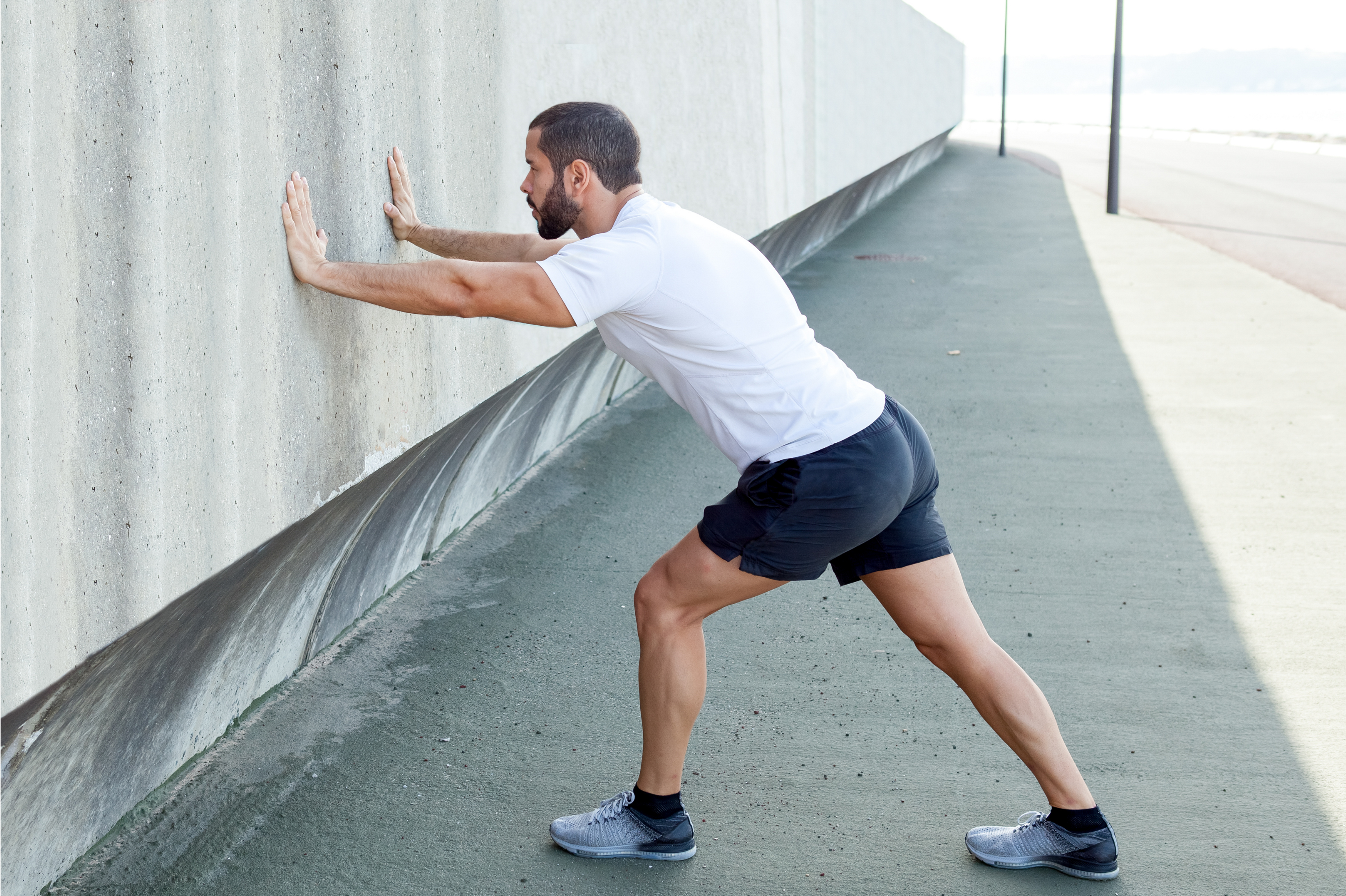Our 6 top tips for preventing Achilles tendonitis in runners
If you're reading this, it's likely you or someone you know has experienced Achilles tendonitis or tendinopathy. You’ve probably seen the setbacks it can cause runners. Now, you want to do what you can to avoid it.
These 6 tips will help you run confidently without having to worry about potential Achilles injuries.
1. Rehab your tendon properly
Proper rehab ensures your Achilles tendon is ready for running. It helps prevent future Achilles tendon injuries and keeps you on track with your training.
But what is proper rehab?
What is proper Achilles tendon rehab?
The most effective treatment for Achilles tendonitis in runners is a rehab program that focuses on strengthening your Achilles tendon.
Strengthening is an essential element in rehab because, when injured, your Achilles tendon loses some of its strength – partly due to the injury and necessary rest time required for healing.
Choosing the right exercises for your strength training is also crucial.
Best exercises for Achilles rehab
Two of the most commonly recommended strength training exercises for Achilles tendonitis are:
- Weighted calf raises, and
- Hopping exercises.
While these exercises work exceptionally well for strengthening your Achilles tendon, outside of a structured plan, they may not be as helpful.
The graph below helps explain why.
The graph shows the forces acting on your Achilles tendon during different activities.
It highlights two crucial aspects of calf raises and hopping exercises as they relate to running:
- The forces generated during weighted single-leg calf raises are far less than those created by running.
- Hopping resembles running forces, but a hopping exercise session is usually much shorter than a typical running session.
Based on this, you’ll need to do more than simple calf raises and hopping exercises to properly prepare your Achilles tendon for running.
The key to successful Achilles rehab is exercise progression.
What an effective Achilles rehab plan entails
To properly rehab your Achilles tendon and get back to running safely, you need to:
- Start with easy exercises (like double-leg calf raises)
- Slowly progress to harder ones (like single-leg calf raises with added weight)
- Incorporate a tailored hopping program
- Gradually ease back into running
That last part is often overlooked but vital. Rushing your return to running can lead to setbacks or reinjury.
It’s best to follow a return-to-running plan alternating short walking and running intervals to avoid this.
That way, you can gradually build your Achilles tendon's endurance and bridge the gap between your hopping sessions and desired running goals.
Wondering how structured rehab plans work? Check out our mid-portion and insertional Achilles tendonitis plans in the Exakt Health app. Each is slightly different and designed to help you choose the right exercises, enhance your recovery, and prevent re-injury.
2. Increase training loads slowly
What is training load?
Training load refers to the amount of work you demand from your body and Achilles tendons.
Simply put, it’s how much force goes through your body within a specific timeframe.
Our bodies are great at adapting and getting stronger in response to new training loads, but they need time to do so.
If you increase your training too suddenly, your Achilles tendons may be unable to strengthen quickly enough to cope with the load, leading to overload and Achilles tendonitis.
What affects your training load?
How to safely increase training loads for running
One method to gauge this is to monitor your week-on-week increase in running distance.
If you’ve had an injury
When you’re coming back from injury, your Achilles usually requires more time to adapt to running training loads compared to general fitness training.
In this case, limiting the increase in your total week-on-week training distance to about 10% is best.
If you haven't had an Achilles injury
If you’ve not had an Achilles injury but want to prevent one while upping your training distances, limiting the week-on-week increase to around 20% is likely OK.
However, this method isn't that accurate because it doesn't take training intensity into account.
How to reliably assess and monitor running training load
Recent studies suggest that a more accurate way of determining training loads is considering your acute-on-chronic workload ratio.
Your acute workload refers to the running you’ve done in the last week. Your chronic workload refers to the average weekly running workload over the last 4 weeks.
The workload of each run is calculated by multiplying the distance with the intensity of the run. We’ll discuss this in detail in a future blog post but most new running watches provide this reading.
You can use this reading to plan your training and stay within a safe training load zone.
What training load ratio should you stick to?
- A ratio of 1.2 is generally considered safe
- If you go above 1.5, you may significantly increase your risk of an injury
Please remember, when considering a safe training load for your Achilles tendon, it’s not only about the distances you run. As mentioned earlier, session intensity and terrain also play a role.
When coming back from an injury, it’s often better to postpone high-intensity runs (like tempo or hill sessions) until you can comfortably run your weekly distance at your regular, easy pace.
3. Allow enough recovery time
Why your body needs rest after exercise
When you exercise, your body experiences micro-injuries as a natural part of the process to grow stronger.
After a run, your body uses this time to repair these micro-injuries and strengthen all your tissues, including your Achilles tendons.
Important notes about post-exercise recovery:
- The fitter you are, the more quickly your body recovers.
- The harder your run or workout, the more time your body needs to recover.
What happens if you don’t allow enough recovery time
If you train again before your body fully restores itself, micro-injuries accumulate and can cause overuse injuries like Achilles tendonitis or aggravate existing injuries.
If you’re new to running or returning to running after an Achilles injury, your tendon will need more recovery time. It’s best to avoid running on consecutive days in these cases.
The good news is you don’t have to rest entirely on your recovery days – you just have to avoid activities that put a high load on the Achilles tendon.
Workout ideas for recovery days include:
- Core, upper body, and mobility workouts
- Swimming
- Cycling
- Gentle walks
Signs your Achilles tendon may need more recovery time
- Your calves are still stiff and uncomfortable from your previous workout
- Your Achilles feels stiff or uncomfortable when you take your first few steps in the morning or when you stand up from sitting for an extended period
These days, most people know to schedule recovery days after their runs. But it’s not always possible to get your recovery time 100% right, which is where recovery weeks come in useful.
4. Schedule recovery weeks
What are recovery weeks?
Recovery weeks are “easy” weeks that allow your body to catch up and repair any micro-injuries lingering from previous exercise sessions.
You should typically schedule recovery weeks every fourth week. That means raising your training load incrementally for 3 weeks, then lowering it by about 20% or more in the fourth week.
Ideas for reducing training load in your recovery weeks
There are various ways you can lower your training load in your recovery weeks. Generally, your fitness level and current training goals will determine the best options for you.
Some ideas include:
- Reduce your running distance
- Switch out high-intensity training sessions with easy runs
- Adjust high-intensity sessions to make them easier on your body – for example, doing fewer hill reps or shorter tempo runs
- Substitute some runs with cross-training like cycling or swimming
Another way to keep your training loads in the safe zone and prevent Achilles tendonitis is to change up your strength training schedule.
5. Vary your strength training schedule
Strength training benefits
Current research shows that strength training is an excellent way to reduce the risk of developing overuse injuries like Achilles tendonitis.
It’s why effective running injury prevention plans now commonly include strength training for your Achilles tendon, and all the muscle groups engaged when running.
Strengthening exercises help prevent Achilles tendonitis by:
- Increasing your tissue capacity, improving your tendon’s strength and endurance
- Strengthening all your running muscles, allowing them to absorb and distribute forces more evenly while you run, and reducing the load and impact on your Achilles tendon
However, doing too much strength training on top of your running training can also lead to overtraining and injuries. Being mindful of when and how you incorporate strength sessions into your routine and adapting them as necessary is crucial.
The best way to vary your strength training to avoid overloading your body and prevent injury is by basing any training adjustments on your running schedule.
When to reduce your strength training
If you’re preparing for a race and significantly increasing running distances or speed, you should consider reducing your strength training to short, less frequent sessions (similar to a maintenance dose).
You can drop strength training sessions altogether during the final training stages before a race or if you’re running several races in short succession.
Heads-up!
When to increase strength training
It's a great time to ramp up your strength training during the off-season, when your running volumes and intensity are steady. It helps you build and maintain the strength you’ll need when event training starts again.
6. Pick your running shoes carefully
When choosing running shoes, the most crucial factor affecting your Achilles tendon is the heel-to-toe drop (how much of a heel the shoe has).
The general rule is the flatter your shoe, the harder your Achilles has to work (and the more load passes through it).
Does this mean flat or zero-drop running shoes are bad for your Achilles tendon?
No. It’s only when you suddenly change from wearing more heeled shoes to flatter shoes that you may run into trouble because your tendon won’t have enough time to strengthen and adapt to the higher loads.
If you want to run in flatter shoes, you can. But, you must transition slowly.
That means the transition (to your new flatter shoes) should take at least 12 to 16 weeks.
Adding calf raise exercises over the side of a step to strengthen your tendon into a more stretched position can help this process.
What about stretching?
While people often recommend stretching for injury prevention, it isn’t proven effective for preventing overuse injuries like Achilles tendonitis.
However, some evidence points to a link between a lack of flexibility and a higher risk of acute injuries such as calf muscle tears.
To learn more about stretching, check out our previous article about the top calf stretches for runners. You’ll find out when stretches are helpful (and when not) and how to do them correctly for the best results.
The 6 best ways to prevent Achilles tendonitis when running
Wishing you lots of happy, injury-free running!
Recover better and run safer with the Exakt Health app. Our science-based, personalized injury rehab and prevention plans aim to help you see quicker results than going solo. Plus, they’re simple to follow and easy to stick with.




